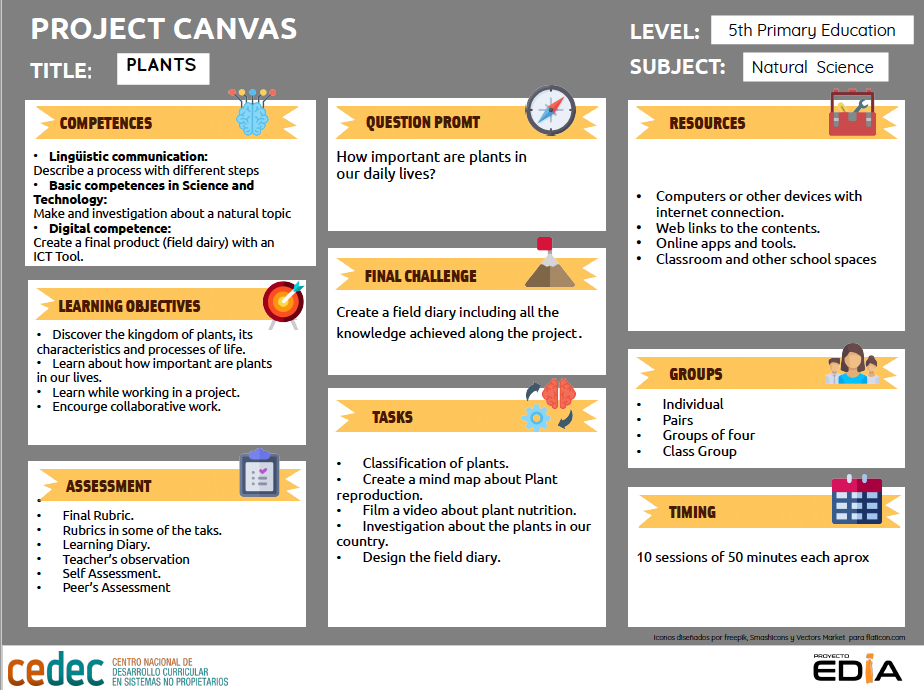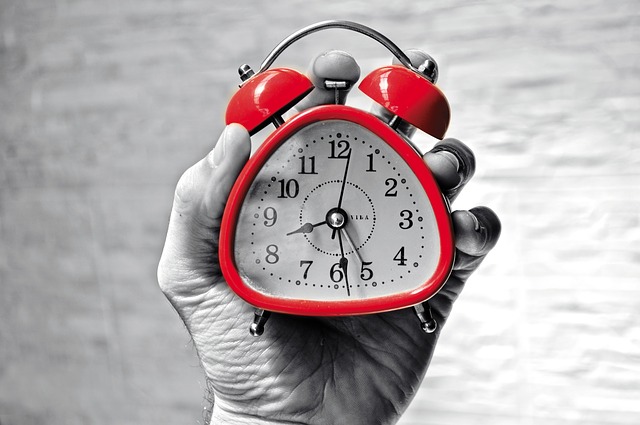- Didactic Guidelines -
General guidelines for teachers.
This project is made up of six different missions whose main topic is Plants. There are activities to do individually, in pairs or in teams.

This project is part of a set of some projects designed to cover all the learning standards of the Natural Science curriculum of Primary Education are published at the BOE (March 1st 2014), pages 17 - 21. With this project you will be able to let your students be autonomous learners and guide them through their learning.
There are activities which involve both individual work, collaborative pair work and group work.
We strongly recommend to work with them through daily aims to get to the end of the project and accomplish each challenge successfully. This means at the beginning of each lesson you should take five minutes to check where your students are and to tell them where you would like them to get at the end of the mission.
For example: 'At the end of the mission each student will have had to finish the presentation, which will be checked by the teacher'.
Each project is student-centred and has several areas of interest:
- In each project, students have to accomplish a task, in order to learn something useful for their big final task.
- There is also a challenge in each project, where they have to collaboratively design a product. They are expected to actively work with information and communication technologies. They will be a portfolio to show all their knowlegde along this set of projects.
- Students also have to complete a learning diary, using a sharing document using the different tips we offer to the students at the end of each mission.
- Student will also have a personal portfolio, where they have to reflect on the different contents they are working on, they have to upload the different audios and videos they produce, and they have to share the link to the different post of their project.
To sum it up, they are going to work on all the contents of the syllabus of their level with a project-based learning orientation.
Assessing
For assessment, both you as a teacher, and your students, are expected to use the rubric to assess a field diary (download in editable odt format, download in pdf).
This project is designed to be assessed following this pattern:
- The Teacher will evaluate the final post on the blog - portfolio with all the products produced during the project following the rubric. It will be 40% of the final score.
- The partners will carry out peer assessment the work and grade about how their teamwork has worked. It will be 20% of the final score . The students can generate the different criteria or items to be assessed.
- Students will self-assess the final task using the rubric. It will be 20% of the final score.
The final score will also include a 20% for the teacher to evaluate how the students have been involved in the project or tackled the different activities.
At the end of the project the student will have been able to:
- Classify plants by different criteria.
- Explain how plant reproduce.
- Understand and describe the photosynthesis process.
- Identify the different kinds of plant at the sorrounded area.
- Create a report with all the achieved knowledge and the investigation.
- Reflex about the learning process and the achieved knowlegde along the topic.
Curricular references
- Contents
-
Contenidos siguiendo el Curriculo del BOE (March 1st 2014), pages 17 - 21.
Bloque 1. Iniciación a la actividad científica.
- Iniciación a la actividad científica. Aproximación experimental a algunas cuestiones.
- Utilización de diferentes fuentes de información (directas, libros).
- Lectura de textos propios del área.
- Utilización de las tecnologías de la información y comunicación para buscar y seleccionar información, simular procesos y presentar conclusiones.
- Trabajo individual y en grupo.
- Técnicas de estudio y trabajo. Desarrollo de hábitos de trabajo. Esfuerzo y responsabilidad.
- Planificación de proyectos y presentación de informes.
- Realización de proyectos.
Bloque 3. Seres vivos.
- Las plantas: La estructura y fisiología de las plantas. La fotosíntesis y su importancia para la vida en la Tierra.
- Respeto de las normas de uso, de seguridad y de mantenimiento de los instrumentos de observación y de los materiales de trabajo.
- Interés por la observación y el estudio riguroso de todos los seres vivos.
- Hábitos de respeto y cuidado hacia los seres vivos.
- Uso de medios tecnológicos para el estudio de los seres vivos.
- Learning standards
-
Estándares de aprendizaje siguiendo el Curriculo del BOE (March 1st 2014), pages 17 - 21.
Bloque 1. Iniciación a la actividad científica.
1.1. Busca, selecciona y organiza información concreta y relevante, la analiza, obtiene conclusiones, comunica su experiencia, reflexiona acerca del proceso seguido y lo comunica oralmente y por escrito.
1.2. Utiliza medios propios de la observación.
1.3. Consulta y utiliza documentos escritos, imágenes y gráficos.
1.4. Desarrolla estrategias adecuadas para acceder a la información de los textos de carácter científico.
2.1. Manifiesta autonomía en la planificación y ejecución de acciones y tareas y tiene iniciativa en la toma de decisiones.
3.1. Utiliza, de manera adecuada, el vocabulario correspondiente a cada uno de los bloques de contenidos.
3.2. Expone oralmente de forma clara y ordenada contenidos relacionados con el área manifestando la compresión de textos orales y/o escritos.
4.1. Usa de forma autónoma el tratamiento de textos (ajuste de página, inserción de ilustraciones o notas, etc.).
4.2. Hace un uso adecuado de las tecnologías de la información y la comunicación como recurso de ocio.
4.3. Conoce y utiliza las medidas de protección y seguridad personal que debe utilizar en el uso de las tecnologías de la información y la comunicación.
4.4. Presenta los trabajos de manera ordenada, clara y limpia, en soporte papel y digital.
4.5. Utiliza estrategias para realizar trabajos de forma individual y en equipo, mostrando habilidades para la resolución pacífica de conflictos.
4.6. Conoce y respeta las normas de uso y de seguridad de los instrumentos y de los materiales de trabajo.
5.1. Realiza experiencias sencillas y pequeñas investigaciones: planteando problemas, enunciando hipótesis, seleccionando el material necesario, realizando, extrayendo conclusiones, y comunicando los resultados.
5.2. Realiza un proyecto, trabajando de forma individual o en equipo y presenta un informe, utilizando soporte papel y/o digital, recogiendo información de diferentes fuentes (directas, libros, Internet), con diferentes medios y comunicando de forma oral la experiencia realizada, apoyándose en imágenes y textos escritos.Bloque 3. Seres vivos.
2.4. Observa directa e indirectamente, identifica características y clasifica plantas.
2.5. Utiliza guías en la identificación de animales y plantas.
2.6. Explica la importancia de la fotosíntesis para la vida en la Tierra.4.1. Muestra conductas de respeto y cuidado hacia los seres vivos.
4.3. Manifiesta una cierta precisión y rigor en la observación y en la elaboración de los trabajos.
4.4. Observa y registra algún proceso asociado a la vida de los seres vivos, utilizando los instrumentos y los medios audiovisuales y tecnológicos apropiados, comunicando de manera oral y escrita los resultados.
4.5. Respeta de las normas de uso, de seguridad y de mantenimiento de los instrumentos de observación y de los materiales de trabajo. - Key competences
-
At the end of the project the student will have worked and developed these competences:
- Lingüistic communication:
- Student will be able to describe a process with different steps such Photosynthsis.
- Students will be able to write down a report with the results of their investigation.
- Maths competences and basic competences in Science and Technology:
- Students will be able to make and investigation about a natural topic such plants.
- Digital competence:
- Students will be able to create a final product (field dairy) using an ICT Tool.
- Students will be able to use different links to investigate in the net.
- Learn to learn competence:
- Students will be able to reflex about their learning process everyday by using a tool such a Learning Diary.
- Social competences:
- Students will be able to work in group and asses their working along the project.
- Students will be able to make group decisions to achieve the final product.
- Entrepreneurship competences:
- Students will be able to work automously by following the steps of the investigation.
- Cultural competences:
- Students will be able to learn about the plants of the surrounded area and value their existence.
- Lingüistic communication:
Timing
This project implies the use of about ten or eleven fifty-minute lessons. The timing is, obviously, approximate. It will depend on the learning pace of the students and on their interests and the activities done in class.
The ten - eleven lessons could be used according to this guide:
- Three of the lessons will be used for the first three missions.
- The forth and the fifth missions will take us two lessons each.
- Another two lessons will be used to create the field diary with all the information for the Portfolio.
- There is an extra lesson about Present simple for scafolding the understanding of the grammar the students will need to descrive a process.
- And the last lesson will be a good opportunity to assess students and do the collaborative assesment. And also it would be great to evaluate the project itself.
Resources
ICT resources/apps/tools
For this project you will need the following links to different sites.
- DKfindout! Plants
- Wordreference Dictionary
- Eden project: What's pollination? A diagram for kids
- National Geographic Kids: The life cycle of flowering plants.
- Science made Simple: How do plants have babies?
- Rookie Parenting Science: Photosynthesis and Respiration in plants.
- Photosynthesis in Education: Photosynthsis for Kids.
- Cool Kid Facts: Photosynthesis Facts.
- Photosynthesis for kids: How plants make food? - Animation Science.
- English Grammar Online. Present simple Test Level 1
- English Grammar Online. Present simple Test Level 2
- English Grammar Online. Present simple Test Level 3
Tools:
How to
These videotutorials could help you cope with activities and missions within the project:
- Step by step directions for creating a mind map
- Cómo usar SWAY por Óscar Herrero.
- Genially, una aplicación genial por Raúl Diego
- Canva. Herramientas digitales básicas para docentes inexpertos por Ingrid Mosquera
- Aprender a crear infografías en Piktochart por Josh Borrás.
- Popplet -- Videotutorial: Popplet. Herramientas digitales básicas para docentes inexpertos por Ingrid Mosquera
- Bubbl.us -- Videotutorial: Bubbl.us. Herramientas digitales básicas para docentes inexpertos por Ingrid Mosquera.
- PlayList about Flipgrid by Norberto Cuartero Toledo
- Tutorial básico de Avidemux por Marco Arrigada
Licensed under the Creative Commons Attribution Share Alike License 4.0
